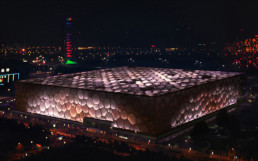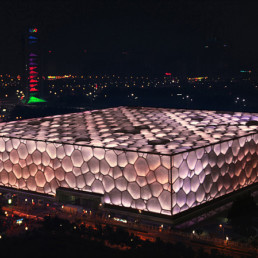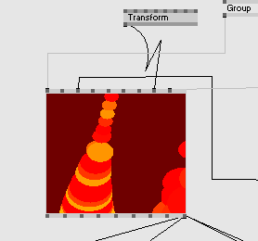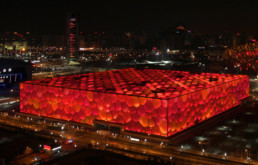Large Scale Installation
National Aquatics Stadium, Beijing, China
This is a large site specific installation by Jennifer Wen Ma ( I did the creative technology direction )
It displays on the bubbles surrounding the structure how China’s day was, every day.
Each day has it’s own different animation based on the I-ching, modified by the mood of the day on Weibo, the Chinese twitter.
The Water Cube is now the Beijing National Aquatics Center. It was originally constructed for the 2008 Summer Olympics in Beijing and later converted into a water park.
The structure is a metal space frame holding up a special plastic film (IETF)shaped into bubbles. Each bubble is illuminated from the inside with rows of addressable RGB LED lamps.
Since each bubble is addressable we can use the water cube as a gigantic low-resolution screen.
Zhao Fei in the foreground was part of the original water cube deployment team during the Olympics and is in charge of the final step of converting the renderings to the specially designed control interface. He is also in charge of the hardware. Zhao Liang , behind him, is in charge of fine tuning the software that generates the daily renderings. In the back Jennifer provides Zhao with guidance. To the right is one of the indefatigable video crew documentarians that followed us around close to 24 X 7
Each day a program calculates what animation the day brings based on the I-ching and modifies the animation according to the total mood of the day on Weibo. For example the day’s animation might be thunder. The mood can make the lightning flashes more frequent, more intense and brighter (or the opposite)
This makes each animation a unique combination of the nature of the calendar day plus the experience of the people that lived that day.
I setup a framework that would read the data from Weibo and the Calendar as an XML file, generate the animations and output them into the Water Cube format.
The content is determined by two parts: The I-Ching which tells us what the nature of each day is, say Thunder, or Fire, Water … and the day’s emotional content in China. The day’s emotion is read by scraping emoji (emoticons) posted on Weibo (Weibo is a micro-blogging platform in China. It is similar to Twitter)
The emotional content affects the day’s nature. For example if today is Heaven (which is symbolized by a white circle) and the day is sad, the circle will grow very little and very slowly. If instead China had a great day, the circle grows quickly to a very large one.


Heaven on two different day states, one is a very happy day, the other a very low energy day. (Move the slider to compare)
Programming this had very specific challenges. We normally render animations in High Definition, but here we were working with a kind of very low definition display as each side is 72 giant bubbles long. And while the bubbles themselves have dozens of lamps in a row along the bottom of each bubble, and each lamp is individually addressable, the effect is that the bubble lights up with one color, or a very gentle gradient. To complicate things further the bubbles do not line up so straight lines are squiggly! On the other hand, basic geometric shapes displayed on the water cube as wonderful abstract images.
For example: Fire starts like this in vvvv:
and ends up like this:
The lighting on the facade of the "Water Cube" National Aquatic Center showcases a fluid light display that changes everyday of the year. Ancient wisdom from the I-Ching and emotional data collected from Chinese micro-blogging sites are combined and analyzed by automated computer programs to interpret each day's unique characteristics and aura. This data is translated into light, color, composition, rhythm and movements on the Water Cube facade.
The creators project did a feature on this:
For more about this project please see Jennifer’s website. Littlemeat.net
The project was also featured on CNN. You can see it here:
Press
Chen, Nan. “Ink meets light,” China Daily, January 18, 2013.
Platt, Kevin Holder. “Beyond Babel, China’s virtual future.” The New York Times, September 9, 2013.
Siemons, Mark. “Alles so shon bunt hier in China.” Frankfurter Allgemeine, July 5, 2013.
Walsh, Brienne. “Emoji in light on the Beijing Water Cube.” Art in America, July 9, 2013.
Xu, Joyce, “New face of Beijing iconic Water Cube.” CNN iReport, July 3, 2013.


















